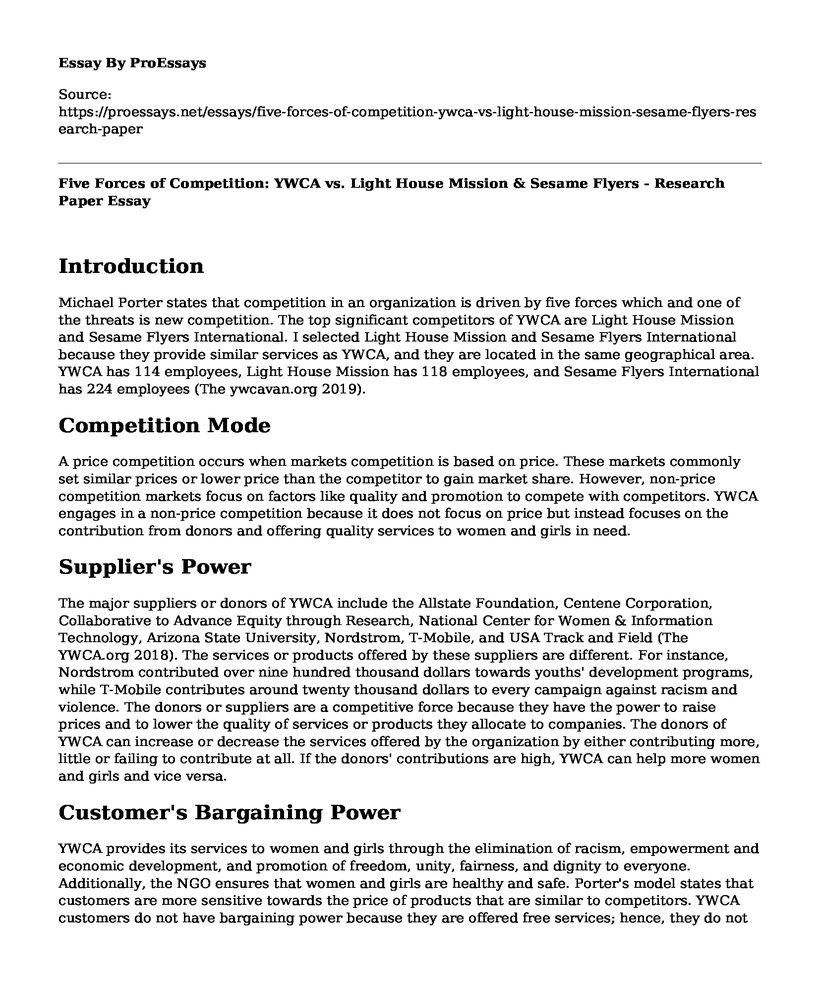Introduction
Michael Porter states that competition in an organization is driven by five forces which and one of the threats is new competition. The top significant competitors of YWCA are Light House Mission and Sesame Flyers International. I selected Light House Mission and Sesame Flyers International because they provide similar services as YWCA, and they are located in the same geographical area. YWCA has 114 employees, Light House Mission has 118 employees, and Sesame Flyers International has 224 employees (The ywcavan.org 2019).
Competition Mode
A price competition occurs when markets competition is based on price. These markets commonly set similar prices or lower price than the competitor to gain market share. However, non-price competition markets focus on factors like quality and promotion to compete with competitors. YWCA engages in a non-price competition because it does not focus on price but instead focuses on the contribution from donors and offering quality services to women and girls in need.
Supplier's Power
The major suppliers or donors of YWCA include the Allstate Foundation, Centene Corporation, Collaborative to Advance Equity through Research, National Center for Women & Information Technology, Arizona State University, Nordstrom, T-Mobile, and USA Track and Field (The YWCA.org 2018). The services or products offered by these suppliers are different. For instance, Nordstrom contributed over nine hundred thousand dollars towards youths' development programs, while T-Mobile contributes around twenty thousand dollars to every campaign against racism and violence. The donors or suppliers are a competitive force because they have the power to raise prices and to lower the quality of services or products they allocate to companies. The donors of YWCA can increase or decrease the services offered by the organization by either contributing more, little or failing to contribute at all. If the donors' contributions are high, YWCA can help more women and girls and vice versa.
Customer's Bargaining Power
YWCA provides its services to women and girls through the elimination of racism, empowerment and economic development, and promotion of freedom, unity, fairness, and dignity to everyone. Additionally, the NGO ensures that women and girls are healthy and safe. Porter's model states that customers are more sensitive towards the price of products that are similar to competitors. YWCA customers do not have bargaining power because they are offered free services; hence, they do not experience price sensitivity (The YWCA.org 2018).
Likelihood of Customers Leaving the Organization
Customers decide to switch from one product to another in preference to price or quality (Porter, 2008). An increase in the cost of a product may lead to the loss of customers. In the same way, customers may switch from one product to another if the quality of the products or services is reduced. The likelihood of customers leaving the YWCA is limited because it the largest organization in the U.S. and offers services to more than two million women and girls. It is among the top 25 largest non-profit organizations in the United States. The customers can leave the organization and go to other competitors if YWCA starts providing inadequate services, maybe because of the loss of donors.
New Competition Emergence
Another competitive force discussed by Michael Porter is new entrants into the market. Porter stated that a new entrant could become a threat if it has the capability of bringing new dimensions, a significant amount of resources, and aspiration of gaining market share (Porter, 2008). The seriousness of the new entrant depends on current barriers and how existing competitors react. The factors determining the opportunity to new competition emergence include accessibility to distribution means, government policy, capital, product differentiation, and economies of scale. YWCA does not experience severe threats if the factors determining new entry are too high.
References
Porter, M. E. (2008). The five competitive forces that shape strategy. Harvard business review, 86(1), 25-40.
The YWCA.org (2018). YWCA 2019 Annual Report. Retrieved from https://www.ywca.org.au/annual-reports/
The ywcavan.org (2019). Financials, Reports and publications. Retrieved from https://ywcavan.org/discover/financials-reports-and-publications
Cite this page
Five Forces of Competition: YWCA vs. Light House Mission & Sesame Flyers - Research Paper. (2023, Feb 22). Retrieved from https://proessays.net/essays/five-forces-of-competition-ywca-vs-light-house-mission-sesame-flyers-research-paper
If you are the original author of this essay and no longer wish to have it published on the ProEssays website, please click below to request its removal:
- Perfect Competition Market and Monopoly Essay
- Essay on New Hotel Techs to Boost Guest Experience: Digital Keys, Smart TVs, and More
- Essay Sample on Don't Fear the Road: Why Road Safety Ads Matter
- Essay Sample on 'Taste the Feeling': Examining Coca-Cola's Advert
- Research Paper Example on Influence of Advertising on Millennial Technology Purchases
- Paper Example on Golden Hearts Org: Improving Local Health through Affordable Care
- Essay Example on Developing a Diversity Training Plan: Strategies and Implementation







